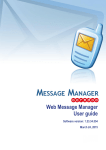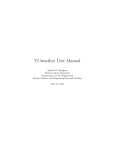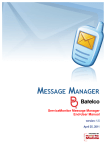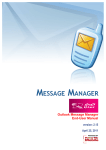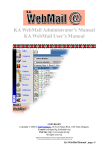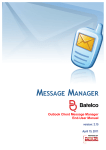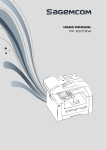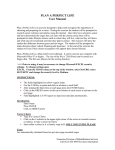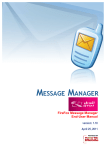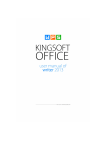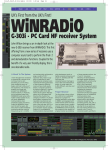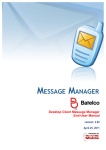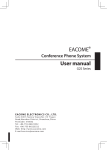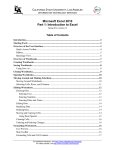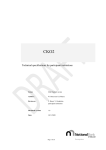Download MessageManager Web Interface User Manual
Transcript
Web Interface Message Manager
End-User Manual
version: 1.23
May 13, 2011
1 of 33
www.PowerMeMobile.com
www.PowerMeMobile.com
PowerMeMobile. Mobile Solutions Provider
Copyright
Copyright © 2001 – 2011 PowerMeMobile Co. All rights reserved. No part of this publication, or any
software included with it may be reproduced, stored in a retrieval system, or transmitted in any form or by
any means, including photocopying, electronic, mechanical, recording, or otherwise, without the prior
written permission of the copyright holder.
Trademarks and Registered Trademarks
Products and product names mentioned in this document may be trademarks or registered trademarks of
their respective owners.
2 of 33
www.PowerMeMobile.com
www.PowerMeMobile.com
PowerMeMobile. Mobile Solutions Provider
Content
INTRO ...........................................................................................................................................................................4 ABOUT THIS MANUAL .................................................................................................................................................4 ABOUT THE WEB MESSAGE MANAGER ......................................................................................................................4 DISCLAIMER ...............................................................................................................................................................5 I. GETTING STARTED ........................................................................................................................................6 I.1. LAUNCHING WEB MESSAGE MANAGER THE FIRST TIME ..............................................................................6 I.1.a. Logging in as a Consumer ......................................................................................................................6 I.2. WEB MESSAGE MANAGER INTERFACE ........................................................................................................7 II. MESSAGING ....................................................................................................................................................10 II.1. CREATING SMS MESSAGES .......................................................................................................................10 II.1.a. Customizing your SMS message. .........................................................................................................11 II.2. CREATING MMS MESSAGES ......................................................................................................................13 II.3. SENDING SMS OR MMS MESSAGES ..........................................................................................................16 II.4. DEFINING FREQUENTLY DIALED NUMBERS IN SPEEDDIAL .........................................................................16 II.5. SETTING LATER DATE AND TIME TO DELIVER YOUR MESSAGE ...................................................................17 III. MANAGING YOUR CONTACTS WITH THE PHONE BOOK ...........................................................19 III.1. PHONE BOOK OVERVIEW ............................................................................................................................19 III.2. HOW TO CREATE A NEW CONTACT .............................................................................................................20 III.3. HOW TO SELECT RECIPIENTS FOR MESSAGES ..............................................................................................22 III.3.a. Mass mailing with Distribution Lists ...............................................................................................23 III.4. HOW TO ORGANIZE YOUR GROUPS AND CONTACTS ....................................................................................23 III.5. PHONE BOOK AND OTHER APPLICATIONS ...................................................................................................24 III.5.a. Importing PhoneBook / Recipients List ...........................................................................................25 III.5.b. Exporting PhoneBook/Recipients List .............................................................................................25 IV. V. MANAGING MESSAGES SENT BY YOU ..............................................................................................26 HANDLING INCOMING MESSAGES IN THE INBOX ............................................................................28 VI. MANAGING MESSAGES TO BE SENT FROM THE OUTBOX ........................................................30 VII. UPDATING YOUR COVERAGE MAP ....................................................................................................30 VIII. ADDING MONEY TO YOUR ACCOUNT ...............................................................................................31 FREQUENTLY ASKED QUESTIONS ...................................................................................................................33 3 of 33
www.PowerMeMobile.com
www.PowerMeMobile.com
PowerMeMobile. Mobile Solutions Provider
Intro
About this manual
This manual is to conveniently assist you with how to use the WebMM, tune it to your
business requirements, and operate it conveniently and efficiently.
We organized the manual as a reference and a small study guide, so that each chapter
stands alone, giving you quick and easy answers to particular questions and step-bystep instructions for specific tasks. You can find the necessary information in the
chapters through the Contents or use Index sections for immediate help in many typical
situations.
Your Web Message Manager is also a highly customizable tool, and your Operator
system administrator can change the options available and the outer look according to
your needs as a client and the Operator’s needs as the provider. Hence the screenshots
in this manual may insignificantly differ from what you have onscreen. Also because of
our ongoing efforts to improve the WebMM performance, the screenshot can show
previous version numbers of the software. In this case the new version has higher
productivity and stability, but the functionality remains the same.
The screenshots in this manual present the ‘fully-loaded’ WebMM with the maximum of
features. Depending on the Operator settings, your actual views of your Web Message
Manager may look different. Please contact your Operator Admin if you want to have a
feature available for you.
This icon signals technical stuff that you may find informative and
interesting but isn’t essential for Web Message Manager everyday use.
Feel free to skip over this stuff, or you may need to show the info to your
system administrator if you experience a problem.
This icon warns you of any potential pitfalls—and gives you the allimportant information on how to avoid them.
About the Web Message Manager
Thank you for choosing Web Message Manager (WebMM) as a most complete websolution for your immediate business communication and internal operation
management. WebMM doesn’t require installation - all its features are accessible online
after logging in.
The web-based application allows you to send text and multimedia1 messages to mobile
phones all over the world from any PC connected to Internet.
You as a user of the Web Message Manager can:
1
•
Create advanced SMS / MMS 1 messages with the help of templates,
personalization and customization features, using various media files;
•
Save any or your created messages for future use and editing;
•
Send your messages to multiple recipients from any PC connected to Internet,
using the configurable message templates or creating messages from scratch;
Please confirm availability of this service from your mobile operator.
4 of 33
www.PowerMeMobile.com
www.PowerMeMobile.com
PowerMeMobile. Mobile Solutions Provider
•
Send your messages to multiple recipients from their specially defined mobile
phones, using the Web Message Manager as an intermediary link;
•
Receive messages to your WebMM, and forward them if necessary;
•
Keep a flexible Phone Book provided with the nested groups of contacts, birthday
reminders, advanced search and many other features, and share your contact
database with your enterprise server (Enterprise Edition only);
•
Quickly define message recipient lists, using both the Phone Book or manual
input;
•
Trace the outgoing messages history and monitor the delivery status of the
messages sent from the PC or from the dedicated mobile phones.
•
Always work in your familiar environment, because your message templates, the
contacts in your Phone Book, and other settings are saved on your Operator’s
server.
Please note that availability of the features above depends on your Operator’s
settings and the software edition you are using. Please also remember that Web
Message Manager is a web-based application, that is why in order to boost its
performance and reduce unnecessary traffic, it uses the ‘loading on demand’
approach wherever possible. For example, when you are creating a new
contact, the mobile number entered is not checked automatically. Instead, you
have to click the checkbox next to the mobile number to initiate the checking
(see Figure 13).
The Web Message Manager is just one of many useful products offered by
PowerMeMobile Co. For the complete list of supported applications, please visit
www.powermemobile.com.
PowerMeMobile Co. is constantly working on improving Web Message Manager, so
there may be insignificant differences between the actual WebMM looks and the
screenshots in this manual. Also a screenshot may show a previous version of the Web
Message Manager, in this case the productivity and stability is improved but the
functionality remains the same.
Disclaimer
PowerMeMobile Co. makes no representations or warranties with respect to the contents hereof and
specifically disclaims any implied warranties of merchantability or fitness for any particular purpose.
Further, PowerMeMobile Co. reserves the right to revise this publication and to make changes from time
to time in the contents hereof without obligation to notify any person of such revision or changes.
While every reasonable precaution has been taken in the preparation of this document, neither
PowerMeMobile Co. nor its development team assumes responsibility for typos, errors, or omissions, or
for damages resulting from the use of the information contained herein.
The software application described in this manual is intended exclusively for clients who acquired it
legally and are bound by the appropriate License Agreement. Any unauthorized copying and distribution
of this software application is an infringement of the copyright law and can be severely prosecuted.
Under no circumstances the Company which provides the client with this software application bears any
responsibility for losses or damages which the client may incur as a result of using the described software
application, neither it bears any responsibility for losses or damages which a third party may incur as a
result of the client using the application.
All personal and geographical names and other proper names, as well as phone numbers used in this
manual are completely fictitious, any references to real persons or organizations are strictly accidental.
5 of 33
www.PowerMeMobile.com
www.PowerMeMobile.com
PowerMeMobile. Mobile Solutions Provider
I. Getting started
I.1. Launching Web Message Manager the first time
Web MessageManager (WebMM) is the web-based application which doesn’t require
any installation. To launch it you just need Internet connection and Internet Explorer
version 7 or later (alternatively, you can also use Firefox 2.x or later, or Safari 4.0 or
later, or Chrome). All WebMM features are accessible online after you log in.
The first time you run the application, the Login screen appears (see Figure 1). Even
before you log in, you can define the language for the interface (see the top-left corner
in Figure 1).
Figure 1. Web Message Manager: Login page.
To log in to Web Message Manager, you must do the following:
1) Open your Internet browser and type the Web MessageManager’s webaddress into the browser’s Address bar.
2) Allow the browser to load the page, then enter your login details in the fields
at the Login page (see Figure 1). Use the information you received from your
provider to fill in the fields in the Login page:
•
Customer ID (digits only);
•
Username;
•
Password.
You can select the Remember password box if you want the application to
store your password in its configuration so that you do not need to log in
every time you restart your computer.
Please note that storing your password in your computer is not secure,
especially if you share your computer with other users.
After you click Login, you get access to your user account via WebMM.
I.1.a. Logging in as a Consumer
In case you are using the Consumer mode of WebMM, the fields to fill in for the login
are just Username and Password (no Customer ID).
6 of 33
www.PowerMeMobile.com
www.PowerMeMobile.com
PowerMeMobile. Mobile Solutions Provider
Please note that in the Consumer mode you have to type your phone number. In this
case, if you are in the country of the Operator, you can omit the country code,
substituting it with ‘0’, as shown in Figure 2.
Figure 2. Logging in as a Consumer.
If you forget your password, you can press Reset password. Then the new password is
sent to your mobile phone via SMS, and you can use it for logging in.
Another feature which the Operator can make available for Consumers is WebMM
Token. If this feature is configured, the Customer is given a unique URL which lets the
Customer access all the WebMM functionality directly, without providing the login
information. In most cases a Token expires after a certain time (configurable by the
Operator).
I.2. Web Message Manager Interface
For your convenience, all WebMM windows are uniform in their structure. Every window
contains 3 sections: the Toolbar (left side); the Main section (centre); the Operator’s
banner section (top) and the Top bar (top of the screen), as shown in Figure 3.
Naturally, the Main section view depends on the tab selected in the Toolbar on the left.
7 of 33
www.PowerMeMobile.com
www.PowerMeMobile.com
PowerMeMobile. Mobile Solutions Provider
Figure 3. The full view of the Web Message Manager.
The ToolBar is the control panel of the program and is located on the left side of the
main window. The buttons are used to switch between the Web Message Manager
interface pages, which are shown in the centre, a kind of a work bench of the webapplication. Thus, the possible views of the Main section are:
• Messaging. This button opens the main messaging page which allows you to
create or modify your SMS / MMS messages, set the recipients, define message
templates, calculate message cost, etc.
• Phone Book. The Web Message Manager provides a sophisticated phone book
facility, enabling users to handle contacts. Phone book search, adding and
editing tools are available on this page.
• Sent. All messages which were previously sent are shown here. The message
status enquiry and resending option are available on this page.
• Inbox. All messages which have been sent to you are kept here. You can read
them here, reply to them if necessary, and export the messages for external use.
• Outbox. In this page you can manage the messages which were prepared for
sending but have not been sent yet.
• Coverage. This button opens the list of GSM networks to which the Web
Message Manager can send messages. Searching by county and/or operator is
available on this page.
For your convenience the buttons in the Web Message Manager interface have roll-over
tips.
Please note that your Web Message Manager is a part of a big software complex
called MessageManager Platform. Hence, the WebMM outer look necessarily
depends on the settings your Operator applied when your customer and user
were created. Some information pieces which presentations may vary are the
following:
8 of 33
www.PowerMeMobile.com
www.PowerMeMobile.com
PowerMeMobile. Mobile Solutions Provider
•
•
•
•
•
The Inbox button in the Toolbar is not shown if the Inbox feature is not
available for your user;
When the Messaging tab is selected, the balance is shown in the top
right corner if the customer is prepaid, and the package expiration date is
shown if packages are used;
The Language menu can be omitted for Operators with English-only
subscribers;
Depending on your Operator settings, the Balance Info section in the top
right corner can also show the number of messages remaining;
There is no SMS/MMS choice in the Messaging view if the user is not
allowed to send MMS messages.
9 of 33
www.PowerMeMobile.com
www.PowerMeMobile.com
PowerMeMobile. Mobile Solutions Provider
II. Messaging
Every time you log into WebMM, the Messaging page appears (see Figure 4). Of
course, you can log off to come back to the Login page any time by clicking the Log off
customer ID: .. User: … link in the top right corner of the page (see Figure 3).
Figure 4. Web MessageManager: Messaging page.
Your username and the number of units to pay for your messages to be sent are shown
at the top of the Messaging page. If you are a user of a Postpaid customer, your
balance is not shown. The cost of sending the message depends on the type of your
message (MMS messages are much more costly), the number of the recipients, and the
destination GSM network(s).
II.1. Creating SMS Messages
The Messaging page is your main workbench to compile and send messages, both
SMS and MMS types.
To create new SMS message, please:
a. Select the SMS option button
at the top of the screen.
b. Define the Originator, which serves as the signature for your messages. You can
choose the Originator from the drop-down list. If you want to change the list of
the Originators available for you, you must contact your Operator Administrator
for this.
10 of 33
www.PowerMeMobile.com
PowerMeMobile. Mobile Solutions Provider
c. Define the recipient of the message. You can either type the recipient’s phone
number directly into the Sent to field or choose the recipient from the Phone
Book. To use the Phone Book option, click the
icon. To send the message
to more than one recipient simultaneously, use the ‘;’ symbol to separate phone
numbers in the Send to: field. However, instead of typing the phone numbers
manually, you may also try our new feature, that of compiling a multiple-recipient
list from the PhoneBook (please see Chapter III.3. How to select recipients for
messages).
d. Define the language of the message. English and Arabic languages are currently
available in the Message combo box, the latter language can be with Arabic or
Latin numbers.
e. Define the Type of the SMS. You may choose one of the following types by
selecting the relevant box:
• Flash: this is usually used to inform the client about the immediate balance
(some providers do it after each connection). The recipient then sees the
SMS instantly on his phone handset, but this message is NOT automatically
saved in the recipient’s Inbox. Flash SMS messages can also be used for
delivering promotional materials (the Flash message feature availability
depends on the Operator settings);
• Private: if you choose this option, this message is not shown on your detailed
account statement.
• Blinking: this option is available for certain Nokia mobile phone models
ONLY. The recipient then sees the blinking message on his phone handset.
Frankly, this SMS type is used quite seldom, as it has an openly promotional
character (the Blinking message feature availability depends on the Operator
settings).
f. Check the cost of the message. To keep track of your expenses, click the
calculator-looking
icon. Then you are shown how many currency units are
required for sending the current message.
g. Preset the Message. If you feel like you just created a very good message worth
to be saved for future use, please click Preset Message…
icon. This facility
allows you to have a number of “preset” messages, or templates, saved for a
quick reuse.
Usually your SMS text in WebMM cannot exceed 459 characters (spaces including), if
in English, and you might want to avoid some service characters like ‘[‘, ‘\’, ‘]’, ‘^’, ‘{‘, ‘|’,
‘}’, ‘~’, because each of them is counted as 2 characters, not 1. How big is your current
message is shown literally right behind your text.
Please note that if your SMS message is in Arabic, as a rule, it cannot exceed 201
characters (spaces including). Both SMS text limits (for English and for Arabic) depend
on your Operator’s settings.
II.1.a. Customizing your SMS message.
If you want to customize your message, you can use the WebMM context menu, evoked
by right-clicking in the message text area (Figure 5). Then your message will look lively
11 of 33
www.PowerMeMobile.com
PowerMeMobile. Mobile Solutions Provider
and personal, which may very well mean good customer relations, and good customer
relations may mean good profit.
Figure 5. The customization menu for your message.
Insert Smiley: This tool provides a set of the so-called emoticons, which can add life to
your message text, especially with younger audience. To insert a smiley, please, rightclick the text, choose Insert Smiley and then pick the smiley you like. Do not use them
too much in your business communication—some serious people still find them too
ambiguous .
Personalization Features: This option allows you to create and then personalize your
message by inserting recipient name, initials, prefix/title etc. into the uniform message
text as variables. This is a valuable tool for efficient mass messaging which will not look
mass and impersonal.
For example, you want to send the birthday wishes to two recipients:
Mr. Smith and Ms. Ross. Firstly, define the recipients’ phone numbers in the
Sent to: field (you can type them directly into this field or choose them from
the Phone Book). Then write a message: “Happy birthday. Many happy
returns of the day!”. Place the cursor where you want to insert the names,
after the word ‘birthday’ in our example. Use the Personalization Feature in
the Message context menu and choose Insert Recipient’s Full Name with
Title. The WebMM then inserts the individual recipient names and titles into
the message text automatically.
Note that instead of writing separate messages to each of two (or two
thousand) recipients, you write only one message, and the necessary
personalizing information is taken from the Phone Book for you.
Insert Custom Tag. This feature is even more sophisticated, as it can use the data
fields imported into the WebMM from the external sources. While messaging, custom
tags are used to provide large numbers of clients with some individually prepared
information.
Let us give you another example. Supposing you want to inform your clients
about their current account balance. First of all, create an external file or
database (CSV, MS Excel, TXT) containing the necessary information: the
name, phone number, and current account balance of every client. Here is an
example of what your CSV file might look like:
Customer Name,Phone Number,Balance
Mr. Ahmad, 9659666666,20
Ms. Adel, 9659777777,35
Then import this file into the WebMM Recipients List. Use the Tools feature
of the Phone Book (see Chapter III.5.a. Importing PhoneBook / Recipients
List for details). Note that during the import you should mark the account
balance column as a ‘Custom field 1’.
12 of 33
www.PowerMeMobile.com
PowerMeMobile. Mobile Solutions Provider
After creating the Recipients List, return to the Messaging page and compose
the text of the message, using the right-click context menu to insert your
custom field, for example:
“Dear <%fullname%>, your current balance is
<%Custom 1%>$. <%date%>”.
As you see, here we engaged both Personalization Features
(<%fullname%>, <%date%>) and the Custom Tag (<%Custom field 1%>).
The WebMM inserts the individual recipient names, titles and account
balances automatically.
Your messages then look like this:
“Dear Mr. Ahmad,
20$. <%date%>”,
your
current
balance
is
“Dear Ms. Adel, your current balance is 35$.
<%date%>”
The WebMM puts in the date once the message is sent.
Thus again, instead of writing a multitude of individual messages for many
recipients, you create an external database with the necessary custom fields,
import this database to the WebMM, compose only one SMS, and send it to
all your clients by just one click. The WebMM does most of the tedious job for
you.
Note that Insert Custom Tag option is activated ONLY if the imported
Recipients list is provided with AT LEAST ONE custom field. It is possible to
define up to 10 custom fields for each list.
II.2. Creating MMS Messages
As you may guess, there are a lot of options common for SMS and MMS messaging.
To create new MMS message, please:
a. Select MMS option button
at the top of the screen. The SMS
messaging area is changed to the MMS messaging (Figure 6).
b. Define the originator, which serves as the signature for your messages. You can
choose the Originator from the drop-down list.
13 of 33
www.PowerMeMobile.com
PowerMeMobile. Mobile Solutions Provider
Figure 6. Web Message Manager: MMS Message Preparing Page.
c. Define the Recipient by entering a phone number or choose a recipient from the
Phone Book by clicking the
icon. You can send your MMS message to
multiple recipients, just like with an SMS message (see Chapter II.1. Creating
SMS Messages).
d. Select the Private box if you do not want this message to be shown on your
detailed account statement.
e. Сheck the number of currency units required for sending the current message,
click the
icon.
If you have some contacts you are using frequently, you can also use the Speedial
feature, the same as for SMS sending (see Chapter II.4. Defining frequently dialed
numbers in SpeedDial).
However, unlike with SMS messages, you must type the Subject of the message in
corresponding field above the message box. Your MMS message cannot be sent until
you put some subject for it.
To begin composing an MMS message itself, please click the
Multimedia Message Composer screen then appears ( see Figure 7).
button. The
14 of 33
www.PowerMeMobile.com
PowerMeMobile. Mobile Solutions Provider
Figure 7. The Multimedia Message Composer screen and the first button to press.
To start creating an MMS message, press the
button. Now you can:
•
add pictures (by pressing the
button or by dragging-and-dropping the file into
the frame). The supported file types are: bmp, gif, jpeg, jpg, mbm, png, tif, tiff,
wbmp. You can also add a video file in the 3gp format.
•
insert text by typing it in the Text area, or you can click
text from the existing txt file.
•
add audio with the help of the
button (the drag-and-drop option is also
available for this). The supported file types are: aac, amr, awb, mp3.
•
change the color of the background.
To Delete the selected picture or audio file, press the
button to insert the
button.
To change the position of text and image within the frame, please, use the
button.
You can see then how the
and
icons change their position on the gray area
located to the right of the buttons. Use the green lever on this screen if you want to
resize the image/text parts. You may especially need it after you check how the
message looks like, using the
button for preview. If the appropriate feature is
available for your software, you can also select a telephone model for which the MMS
message is to be previewed.
When the first frame is complete, you can insert the next blank frame to continue by
pressing the
button again.
With the help of the frame buttons range, you can delete frames and change the order
of their display. You can also create a new frame on the basis of the existing frames.
15 of 33
www.PowerMeMobile.com
PowerMeMobile. Mobile Solutions Provider
For this, select the frame and click
button. The frame is then duplicated. You can
now change the text and picture position, resize the image, insert a new image or text,
edit the text, and change the background color. The other buttons in the row let you
delete a frame, or move it left or right.
The default Duration for each frame is set to 20 seconds, which you can change, of
course. The only real limit is the MMS message size, which generally should not exceed
100-150 kB.
To save the message please click
and choose the location on your computer's hard
drive. Then you can edit it later or send to another recipient. You’d better remember the
path for the file, but if you lost it, you can search the file by its extension (*.MMS).
To edit or resend the existing MMS Message, click
you would like to edit and make the changes.
button, choose the message
If your Operator settings allow this, you can preview the whole MMS message. Please
select the model of the phone you want to preview the message on. For this, use the
drop-down list
message.
and click the
button to play the
When the MMS message is complete, you can return to the Web Message Manager
Messaging page by clicking
button and send the message.
Please note that with some Operators the cost of your MMS message can depend on its
size, and your Operator can charge your MMS message in ranges. For example, the
first 50 Kb of your MMS message cost 0.05 currency units per Kb, then every Kb added
costs 0.10 currency units.
II.3. Sending SMS or MMS Messages
The Web Message Manager gives you three convenient choices for sending SMS /
MMS messages to their recipients: through the Send button, Speedial buttons, or
Managed Campaign/Deferred Delivery button.
Clicking the Send button is an ordinary way of sending messages. The Speedial and
Deferred Delivery buttons are more advanced features.
II.4. Defining frequently dialed numbers in SpeedDial
If there are some favorite recipients to whom you send messages very frequently, you
can set Speedial buttons for them. The Speedial buttons allow you to send messages
to the predefined addresses with just one click.
To configure the Speedial buttons’ settings, please:
a. Click the
8).
icon. The SpeedDial Configuration screen appears (see Figure
b. Fill in the form by specifying the Button Label and the recipient’s mobile number.
You can type the phone number directly in the entry box or press the gray button
next to the Mobile number entry box and choose the number from the Web
Message Manager Phone Book.
16 of 33
www.PowerMeMobile.com
PowerMeMobile. Mobile Solutions Provider
c. Click OK to save the Speedial phone numbers and return to the Messaging
screen. Click Cancel to return to the Messaging window without saving Speedial
phone numbers.
Figure 8. Speedial Configuration screen with buttons defined.
After you specify the Speedial labels, they are displayed under the message box in the
Messaging window (see Figure 9):
Figure 9. Speedial Buttons with new labels in the Messaging Window.
Now you can send a composed message immediately by clicking the appropriate
Speedial button. Note that using a Speedial button, you do not need to type the
recipient’s phone number in the Send To field every time you wish to send a message
because the recipient’s number is already indicated in the Speedial configuration.
II.5. Setting later date and time to deliver your message
The Managed Campaign/Deferred Delivery option enables you to define the exact
time your message will be delivered to its recipient(s). Please remember that this option
can be switched on/off for every separate user.
To set up the Deferred delivery, please:
a. Click
button at the Web Message Manager Messaging page.
Alternatively, the button can be called Managed Campaign.
b. Indicate the Date and Time of the delivery through the built-in Calendar and the
Time controls.
c. Press Send to send the message and finish the Managed Campaign/Deferred
Delivery dialog.
17 of 33
www.PowerMeMobile.com
PowerMeMobile. Mobile Solutions Provider
Figure 10. Managed Campaign/Deferred Delivery menu.
When you set the deferred delivery date and time for your message, please remember
about the time zone differences.
18 of 33
www.PowerMeMobile.com
PowerMeMobile. Mobile Solutions Provider
III.Managing your contacts with the Phone Book
Being an instrument for business communication, the Web Message Manager can store
your extended contacts in its Phone Book, conveniently organize them for you into
multi-level groups, and instantly deliver them at your disposal. Here you can:
•
Create, edit, and delete contacts,
•
Create, rename, and delete groups and subgroups,
•
Copy and move your contacts and subgroups from one group to another,
•
Select multiple recipients for your messages.
You can also share the contact information with external sources, i.e., export it to the
CSV (Comma Separated Values) files and import new contacts from external
databases.
The Phone Book itself is stored on your Operator server, which enables you to access
it from any computer with Internet connection.
III.1. Phone Book overview
The Web Message Manager is equipped with the advanced Phone Book (Figure 11) in
which you can do practically anything necessary to efficiently organize your contacts
and send messages. In addition to groups, the program has the Distribution list, which
you can use as a temporary group containing just the telephone numbers. This can be
handy for promotion message deliveries, when the real names are just not available.
Figure 11. The default Phone Book screen.
19 of 33
www.PowerMeMobile.com
PowerMeMobile. Mobile Solutions Provider
In the Phone Book there is the tree of contacts, which you can edit and delete, as well
as add new contacts into one or several multi-level groups and subgroups. You can
Collapse or Expand the list of all groups and subgroups, using the corresponding links
above the tree of contacts. You can also do it with a separate group, to adapt the view
to your current needs.
To view the contacts included in the group, click on the group’s name. You will see the
list exactly below the tree of contacts.
III.2. How to create a new contact
To create a new contact, you can click the
button, right-click a group and
choose Add contact… button or click the Add the link at the bottom. The Recipient
Information screen similar to Figure 12 then appears.
Figure 12. The default Recipient Information screen.
The Recipient Information screen is composed of several sections: the Recipient’s
personal information, the information about the Recipient’s mobile phone, Reminder
facility for the contact’s birthday, and the Groups. Supply the necessary information step
by step:
a. Fill in the Recipient’s personal information:
• Prefix: Mr., Ms., or Mrs.;
• First name;
• Initial;
• Last name;
• Country (use the drop-down list to select it);
• State;
• City;
• Postcode;
20 of 33
www.PowerMeMobile.com
PowerMeMobile. Mobile Solutions Provider
•
•
Address;
Language (currently Arabic, English, or French).
Not all the fields are obligatory here, but we strongly suggest you put at
least the first or last name, otherwise there will be nothing to include in the
database.
b. Supply the mobile phone number and the country of the GSM operator:
• Country (use the drop-down list to select it);
• Phone number.
As soon as you type the Recipient’s phone number, the Web Message Manager can
provide the name of the Network and the current time in the Recipient’s country if you
select the checkbox (this may take some time depending on how fast your Internet
connection is). This information is taken from the Web Message Manager Coverage
Database (see Figure 13).
Figure 13. Destination network and the Recipient’s local time.
If you type the phone number that is not listed in the Web Message Manager
Coverage Database, you see that the name of the destination network
remains unknown and pressing on the OK button in the lower right corner of
the screen envokes a warning message, telling that the phone number was
incorrect. This means that you cannot add this contact to the Web Message
Manager Phone Book and you cannot send messages to this recipient. The
Web Message Manager updates its Coverage database daily through Internet,
so if the code you entered does not give you any destination network, check
the code again.
c. If you want to impress your clients or partners with how much you care about
them, your next step is to specify the Recipient’s Birthday in the Reminder
section. You can use the inbuilt calendar
to indicate the birthday.
d. Finally, go to the Groups section and choose the group to which a new contact
must belong. To create a new group for the contact, click the
button.
Please note that one contact can be included in several groups, but the record
remains the same, which means that if you make changes in the record, the view
of the record in every group is changed.
e. Click the OK to finish and return to the Phone Book screen.
21 of 33
www.PowerMeMobile.com
PowerMeMobile. Mobile Solutions Provider
III.3. How to select recipients for messages
You can choose any of your contacts to become a Recipient of the message. When
you select a group, the list of contacts show up below the group section (see Figure 14).
Figure 14. The List of Contacts.
To add a contact to the list of recipients, double-click the contact’s name, or select it and
click the
button. In case you want to add the whole group to the recipient list,
choose the necessary group and click the
promotional messages to some target audience.
button. This is especially useful for
To remove a contact from the recipient list, double-click it, or select it and click the
button.
To clean up the recipients list field, click the
button.
To add a recipient not listed in the Phone Book, type the recipient’s phone number in
the entry box and click the
specified in the list.
button. In this case the recipient’s name will not be
All the contacts put in the recipient list are automatically displayed in the Send to field of
the Messaging window.
22 of 33
www.PowerMeMobile.com
PowerMeMobile. Mobile Solutions Provider
III.3.a.
Mass mailing with Distribution Lists
Using Distribution lists is an indispensable method of streamlining your marketing
activities. Your Administrator can compile a number of Distribution lists related to your
marketing needs. You can see them if you press the button highlighted in Figure 15.
Figure 15. The Distribution Lists button.
This evokes the Server Distribution Lists window, where you can select the list you need
(see Figure 16).
Figure 16. Selecting a Distribution list.
There are two types of Distribution Lists: restricted and unrestricted. If the List is
restricted, you can see only the Distribution List name (no phone numbers), its
description and number of recipients in the list. Respectively, if you select a restricted
Distribution List, in the Send to field you get only the number of recipients.
Please remember that you are charged for every message sent to the
selected Distribution List, i. e., for as many messages as there are
recipients in the list.
III.4. How to organize your groups and contacts
Contacts in the Phone Book can be organized into multi-level groups and subgroups.
The following groups are created in the Web Message Manager by default: Clients,
Colleagues, Family and Friends. You can delete these groups, create new ones,
create subgroups in them, and apply many other operations to your groups.
All these operations are performed through the context menu. To open it, simply rightclick the name of the Group or the Subgroup. Here you can fully practice your right-click
skills, because the main way to organize your contacts is the context menu. Open it by
right-clicking the selected group (see Figure 17).
23 of 33
www.PowerMeMobile.com
PowerMeMobile. Mobile Solutions Provider
Figure 17. Contacts list Context Menu.
Using the context menu you can choose one of the following commands:
•
Add contact: add a new contact to the selected group or subgroup;
•
Add subgroup: create a new subgroup in the selected group/subgroup;
•
Rename group: rename the selected group or subgroup;
•
Delete group: remove the selected group or subgroup;
You can also define shortcode numbers for SMS groups, so that when you enter the
shortcode number into the Send to field, all the contacts in the group receive your
message. To do this, choose Define SMS Group (see Figure 17). The following form
then appears (see Figure 18):
Figure 18. Creating a group with a shortcode for bulk message sending.
You must select the shortcode from the drop-down list, provide its description, and click
OK. Then the group is created, and you can send the same message to all the contacts
in the group with one click. If you want to change the shortcode list, contact your
Operator Administrator.
III.5.
Phone Book and other applications
WebMM allows you to import and export the Phone Book and the Recipient List to/from
external files and databases. For example, you can include the contacts from your
Outlook or LotusNotes contacts into the Phone Book, or put the contacts from your
Phone Book into Outlook or LotusNotes, without having to re-enter them all.
To get access to these facilities, click the
button (see Figure 19).
Figure 19. The Phone Book Tools screen.
24 of 33
www.PowerMeMobile.com
PowerMeMobile. Mobile Solutions Provider
III.5.a.
Importing PhoneBook / Recipients List
The Import feature allows you to add contacts to your Phone Book or only to your
current Recipients List from external files and databases. To import data to your
PhoneBook / Recipients List from a .CSV file, click Tools→ Import PhoneBook→
…File or Tools→ Import Recipients List→ …File. Find the necessary file and click
OK. This brings you to the form shown in Figure 20.
Figure 20. Importing contact data to your Phonebook or Recipients List.
First, in the Selected group drop-down menu select the group where you want to put
the contacts you are importing. Then highlight the necessary column in the table and
select what field in the Recipient Information screen (see Figure 12) they must be put
into. To do this, use the drop-down menu at the bottom, titled Selected field contains
following data (note the Ignore this field option in the selection).
After you click Import, the contacts appear in your Phonebook.
III.5.b. Exporting PhoneBook/Recipients List
If you need the contact information contained in your Phonebook for external purposes,
you can export it.
To export your PhoneBook / Recipients List, click Tools→ Export AdressBook→
CSV File or Tools→ Export Recipients List→ CSV File. Click the Download… link,
and then specify a convenient location and name for your file in the Save As dialog box.
For exporting your PhoneBook / Recipients List the Web Message
Manager creates a .CSV (Comma Separated Value) file. This format is
probably the most popular one for transferring data from one application to
another, because now the overwhelming majority of database systems are
able to accept comma-separated data. You can read and change this file by
programs like MS Excel, MS Access and many others and save it as usual,
just remember to keep CSV format.
25 of 33
www.PowerMeMobile.com
PowerMeMobile. Mobile Solutions Provider
IV. Managing messages sent by you
This screen displays all sent and stored messages (see Figure 21). You can view,
resend and delete messages here.
Figure 21. The Sent messages list.
When you select a message, you can see its contents in the Current Message field,
check the message’s recipients and status in the Recipients field and the Status field
correspondingly.
To find out the status of the message, select the message and click the Inquire
Delivery Status button.
It is advisable to check your account balance from time to time. To do this, click the
Request Account Statement button. A form similar to the one shown in Figure 22 then
appears. Here you can verify how much money was spent on certain types of messages
in the specified periods of time and all other parameters of the messages you sent.
Please note that your Account Statement can differ from the one shown depending on
your customer type and settings, and the Operator settings.
26 of 33
www.PowerMeMobile.com
PowerMeMobile. Mobile Solutions Provider
Figure 22. Your account statement.
27 of 33
www.PowerMeMobile.com
PowerMeMobile. Mobile Solutions Provider
V. Handling incoming messages in the Inbox
The Inbox feature lets you receive SMS and MMS messages directly to WebMM. SMS
and MMS messages are sent from regular mobile phones to a special shortcode
provided by your Operator. This feature can be used for establishing effective feedback
with your current and potential clients. Please note that its availability depends on the
Operator.
When you first go to the Inbox section, you see a page similar to Figure 23.
Figure 23. Inbox message list.
You may want to click Inbox Options for the beginning, which brings you to a pretty
self-explanatory form (see Figure 24).
28 of 33
www.PowerMeMobile.com
PowerMeMobile. Mobile Solutions Provider
Figure 24. Setting Inbox options.
Here you can:
•
Define how often your incoming messages are to be checked. If you leave the
box unchecked, you have to click the Receive New Messages button every time
you want to see the updated list.
•
Specify whether you want your incoming messages to be removed from the
Operator server after they are received or after they are deleted in your WebMM.
•
Set Autoresponce for MMS and SMS messages (the feature availability depends
on your Operator server settings). Note that if you select Forward message to
phone number, you can access your Phonebook and choose a contact number
there by clicking the button on the right of the corresponding field.
You can also choose to retrieve complete text/content of the messages, but it may
mean a lot of unnecessary Internet traffic expenditures. It is more advisable to highlight
the necessary message in the list and then click Receive Message Text. After that the
message text/content appears in the Current Message field.
You can also delete or forward the message, reply to it, or add the sender number to
the Phonebook (note the corresponding buttons for this).
If you need the message to be used for external needs, you can export its content with
the help of the Export Selected button.
If you point your mouse to the message icon in the Status column, a ScreenTip
notification shows you the message status (Read, Exported, Replied, Forwarded, etc).
Please note that your Operator may charge you for sending the autoresponses
and for forwarding from your Inbox.
Various views of your Web Message Manager, including this one, depend on
the Operator settings. Hence they may look different from the screenshots in
this manual. Please contact your Operator Admin if you want to have a feature
available for you.
29 of 33
www.PowerMeMobile.com
PowerMeMobile. Mobile Solutions Provider
VI. Managing messages to be sent from the Outbox
The Outbox stores all messages which were prepared for sending but have not been
sent yet (see Figure 25). To delete a message from the queue, select it and click the
button. To clear the whole list of messages, click the
button. To send
all messages, click the
button.
Figure 25. The Outbox screen.
If you want to edit the message to be sent, you can get to the Messaging page by
double-clicking the message.
VII. Updating your Coverage map
The Coverage information (Figure 26) is used to allow the Web Message Manager to
determine which GSM Operator (or Network) and which country an SMS/MMS message
must be sent to. This information is used to validate the destination phone number and
to compute the cost of sending the message. It is not possible to send messages to the
networks that are not listed in the Coverage database. The database is updated daily,
so if you have troubles with the number you specified, please check it and try again.
30 of 33
www.PowerMeMobile.com
PowerMeMobile. Mobile Solutions Provider
Figure 26. The Coverage Area Information screen.
This screen displays the list of countries covered by GSM operators all over the world.
The Coverage Area Information is represented by the following fields:
Country: the name of the country the Network is operating in;
Code: the phone code of the country;
Network: the name of the GSM operator which provides the service in the country.
Note that you can send messages only to those operators that are listed in the Web
Message Manager Coverage Database;
TimeZone: Difference, in hours, between the local time in this Network country, and the
Greenwich Mean Time (GMT). In some countries there are several time zones.
Minimum and maximum GMT difference values are indicated in these cases, separated
by comma. For example, USA setting have a GMT Difference of “-8,-10”;
SMS/MMS: indicates whether the Network supports SMS/MMS. If it does, the price of
SMS/ MMS is also shown.
You can perform search using the criteria of Country lookup, Operator lookup or both.
Please type the name of the Country or Operator (Network) in the relevant search box.
You do not have to use wildcard characters like ‘*’ or ‘?’, as the Coverage list
automatically jumps to display all the search terms which contain the string of the
symbols you typed (not necessarily in the beginning of the word).
VIII. Adding money to your account
If you want to see how many currency units you have, click SettingsUpdate. In order
to refill your account, contact your GSM provider. Many providers allow you to do it online by a credit card.
You can also buy the Messaging Platform services by sending SMS message with the
word ‘buy’ followed by the ID of the package you need. If the feature is available for you,
you can send the message from your mobile phone to a designated shortcode, and in
this case the money is taken from your balance in your mobile Operator system. The
31 of 33
www.PowerMeMobile.com
PowerMeMobile. Mobile Solutions Provider
designated shortcode and the list of the packages for sale can be obtained from your
Operator.
32 of 33
www.PowerMeMobile.com
PowerMeMobile. Mobile Solutions Provider
Frequently Asked Questions
I need to send a message of more than 160 characters. Can I do it?
As you may already know, one Latin SMS message can be up to 160 characters, and languages with alternative
code tables (like Arabic or Bulgarian) can contain up to 69 characters. The Web Message Manager can send
longer messages (up to 459 characters) by splitting them into several ones. Please note that this will increase the
cost of your message as many times as there are parts.
I am sending personalized and customized messages, how is the number of characters counted?
The Web Message Manager counts the characters of the biggest entry in the personalization and customization
data. So, don’t forget to take into consideration the number of characters that will be imported using these
features, especially for bulk messages. This way you will keep your message within the requested limit and
reduce the cost.
If I sent a message two days ago, can I access it, edit and re-send it now?
If you have not saved it (see chapters about creating SMS and MMS messages), it is gone. Next time you feel
the message can be useful in future, save it. You can delete it any time if it does not prove necessary.
Can I use different signatures for different users?
Yes, you can have several signatures, or originators, for your messages, and you can choose them from the
Originator drop-down menu, the Messaging screen. Contact your Operator or Distributor to arrange the list of
originators available.
33 of 33
www.PowerMeMobile.com
PowerMeMobile. Mobile Solutions Provider


































